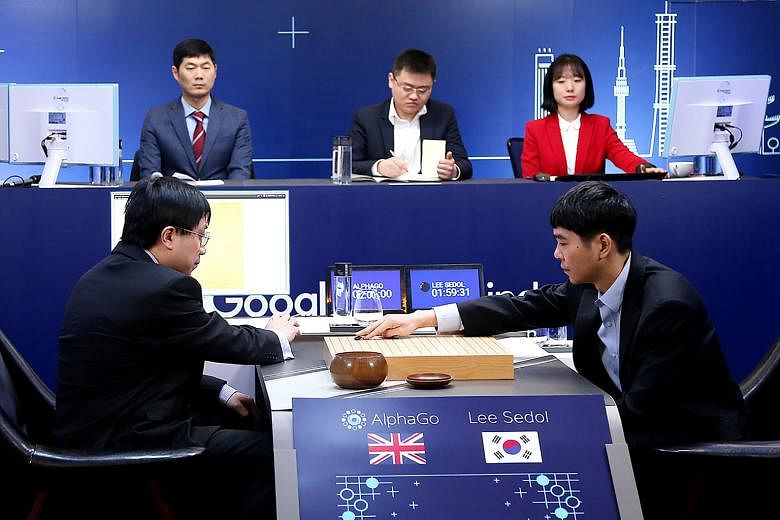Technological change has accelerated in the past few decades.
The digital revolution has significantly changed manufacturing processes, and the ways in which people work, consume and live. Machines powered by computer programs can be designed to plan, reason, present knowledge and learn human responses. Such machines are called intelligent machines, and the intelligence they possess is known as artificial intelligence or AI.
During the industrial revolution of the 19th century, machines replaced skilled weavers in the textile industry. Today, AI machines can do much more. At the leading edge are AI programs such as AlphaGo, developed by the company DeepMind, which in March defeated Korean world champion Lee Se Dol at Go, a board game of such complexity it was long considered impossible for computers to master.
AI may well be able to take the place of the human brain in decision-making in a wide area one day. Of course, human brains are needed to plan logical steps and write computer programs. These programs are then bundled into a workable system, which enables machines to visualise, screen, select and react to external conditions. Once that is done, the rest of the operation may be run by just pressing buttons or touching computer screens. That means what were once sophisticated operations requiring skilled workers can be done by ordinary workers following standard procedures. Many workers, including junior executives, may become redundant.
The impact of technological innovations on the labour market has been extensively debated. American author Marshall Brain, in his book Robotic Nation (2003), stated that intelligent robots "will eliminate a huge portion of the jobs currently held by human beings". He pointed out that there were 114 million employees working for seven million companies in the United States in 2000, according to that year's census. He predicted that more than 50 million jobs would be lost to robots by 2040 or 2050, and over half of the jobs in the US would be done by robots by that time.

American economist Lawrence Summers said in 2014 that "if current trends continue, it could well be that a generation from now a quarter of middle-aged men will be out of work at any given moment".
The Committee for Economic Development of Australia issued a report in June last year stating that almost 40 per cent of jobs in the country, estimated to be five million, could be replaced by AI in 10 to 15 years. Jobs that involved "low levels of social interaction, low level of creativity, or low levels of mobility and dexterity" would likely be affected, according to the report.
The latest projection on the subject, from the World Economic Forum in Geneva on Jan 18, is that there will be a net loss of 5.1 million jobs over the next five years in 15 leading countries. The total loss will be 7.1 million, which is offset by two million newly created jobs.
The disruption to jobs and the labour market due to technological change can to some extent be made up for by high economic growth, which creates new jobs to absorb the surplus labour. Redundancy of labour may still appear if there is moderate economic growth. Singapore's total labour force is now 3.6 million. Let us assume that with advances in technology, only two million workers will be needed some years from now. These two million workers will earn higher wages but the remaining 1.6 million workers will be made redundant.
There is a buffer to accommodate the redundancy of workers should the economy go slow. Out of today's total labour force of 3.6 million, 1.4 million are foreign workers. If the economy is stagnant, the likely solution is to repatriate the foreign workers. But this is a sub-optimal solution as foreign workers, who have adapted to our working environment and culture, are an asset to Singapore. Given the very nature of global economic growth, this ebb and flow is expected. Foreign workers should not be repatriated unless the downswing is long and protracted. Instead, the aim should be to take advantage of AI development to grow the economy to benefit all in Singapore.
AI can raise productivity and efficiency in all sectors with varying degrees of success. The two sectors which have potential to be further developed by AI are transport and health.
In transport, a new concept known as Intelligent Transport Systems was proposed by academics J. C. Miles and A. J. Walker (2006) in a paper published in the British Institution Of Electrical Engineers Proceedings. In this paper, they discuss the potential applications of AI for the vehicle, the infrastructure, the driver, the transport user and "in particular the way these interact dynamically to deliver a transport service".
Singapore's MRT system, which has suffered frequent breakdowns and on occasion, accidents, may be able to benefit from it.
As for the management of both seaport and airport, these are already highly automated but there is still room for improvement, such as by installing more check-in machines and improving security screening systems.
In health, AI can be applied to raise productivity in the manufacture of pharmaceuticals, in surgery, patient care and hospital management, thus strengthening Singapore's role as the leading healthcare centre in South-east Asia.
- The writer is an adjunct professor at Lee Kuan Yew School of Public Policy, National University of Singapore.

